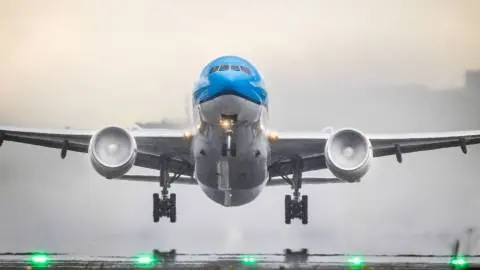Europe leads the way on SAF, but airlines are struggling to hit targets
European airlines are at the forefront of global Sustainable Aviation Fuel (SAF) blending on flights but still need to accelerate quickly to meet the EU’s ambitious targets. The ReFuelEU aviation directive’s feedstock requirements are more restrictive than elsewhere, and the bloc is still likely to continue to rely on imports
European SAF demand needs to fly soon as regulation bites
European air passenger traffic accounts for 27% of global aviation, making it the second-largest aviation market after Asia-Pacific. In 2023, this translated to a jet fuel consumption of approximately 1.38 million barrels per day (65 million tonnes), a figure expected to rise as traffic volumes recover this year.
Europe is often viewed as a pioneer in climate policy and energy transition. The overarching ‘Green Deal’ and the ‘Fit for 55’ package are driving the aviation sector and its fuel suppliers towards greater sustainability. Here are the key policies within this framework:
- The Renewable Energy Directive (RED III) establishes a comprehensive framework for the energy supply sector, mandating that 42.5% of energy must come from renewable sources by 2030. For the transport sector, it sets a renewable energy target of 14%. Additionally, RED III outlines the eligible Sustainable Aviation Fuel (SAF) resources under the Refuel Aviation directive, specifically excluding food and feed crops as feedstocks.
- The ReFuel Aviation Directive mandates that all airlines use a 6% Sustainable Aviation Fuel (SAF) blend for flights departing from EU airports by 2030. Additionally, it requires aircraft to refuel at least 90% of the necessary volume to prevent tankering, which involves sourcing fuel from other locations for return flights. The UK has set an even more ambitious target, aiming for a 10% SAF blend by 2030
Europe's ETS for aviation strengthens SAF business case
Intra-European flight traffic falls under the Emission Trading Scheme (ETS). As part of the ‘Fit for 55’ climate policy package, the free allowances for the aviation sector under the ETS are being gradually phased out. The system will be fully implemented by 2026, with a 75% reduction in free allowances in 2024 and a 50% reduction in 2025. Consequently, airlines will be fully accountable for their CO2 emissions, which will increase fuel costs. The use of Sustainable Aviation Fuels (SAFs) reduces the number of credits airlines need to obtain under the ETS, thereby benefiting the SAF business case.
European blend rates exceed average, but 2% target still tough
According to data from BNEF and IATA, the blend rate in Europe is expected to reach just over 0.6% in 2024, falling short of the 2% target set by the ReFuel aviation directive for 2025. BNEF predicts that airlines may only achieve an average blend rate of around 1.25%. This shortfall could result in fines unless airlines purchase blend certificates. Additionally, airlines face challenges with governance clarity, particularly regarding bunkering outside of Europe and the use of SAF certificates to meet targets and avoid potential sanctions.
Ryanair is expected to be the largest SAF consumer in 2025 by volume
Top 10 European Airlines by expected SAF demand at European airports in 2025 (under the ReFuel aviation directive), in mn. tonnes

Offtake agreements help to get European SAF-supply going
European production of Sustainable Aviation Fuel (SAF) is expected to accelerate in the coming years, driven by offtake agreements secured by European airlines. Several agreements are in place to deliver SAF, including significant contracts between Air France-KLM and Neste (until 2030) and Total Energies (until 2035). DHL and Lufthansa have also disclosed offtake agreements.
To enhance future sourcing, substantial volumes have been agreed upon under Memorandums of Understanding (MOUs). Other suppliers in Europe include OMV and Shell. Additionally, IAG has secured the largest offtake agreement for synthetic SAF to date, covering the period from 2024 to 2039. However, the secured supply alone is insufficient to meet the 2025 requirements, necessitating reliance on the spot market and/or SAF certificates to fulfil the remaining demand.
Capacity set to meet demand despite delays and import reliance
If all planned capacity is realised as expected, there will be enough to meet the required demand and fulfil the 2030 mandate, according to SKY-NRG. However, past delays suggest that new capacity is rarely completed on schedule, meaning the scaling-up process may take longer than anticipated.
Earlier this year, we saw setbacks in capacity realisation. The construction of one of the largest Biodiesel/SAF facilities in Rotterdam was temporarily halted. Similarly, BP announced it would scale back its SAF production plans in Rotterdam, citing challenging market conditions with lower prices. This could impact offtake agreements and spot market supply. Short-term oversupply might be a factor, as more production capacity in the US and Asia comes online and flows to Europe. A sluggish phase leading up to the 2% obligation in 2025 could also contribute to this.
Despite these setbacks, new announcements continue to emerge, such as Neste’s plans in Rotterdam. Complicating matters, refinery margins could shift due to competition with renewable diesel (HVO-100), as facilities can often switch output without significant cost. Given the global nature of the market, Europe will not be able to fully meet its own SAF demand and will need to rely on imports from North America or Asia, with this deficit expected to grow over time.
Feedstock and trade dynamics
The domestic supply of agricultural and waste feedstocks in Europe is quite limited compared to the mandated amount of SAF required by 2030. Additionally, EU criteria for qualifying feedstocks are generally stricter than those in North America or Asia, further reducing the potential supply pool. For animal fats and used cooking oil (UCO), collection and distribution networks in Europe are well-established, ensuring available resources are converted into biofuels.
However, there may be a shift from using these feedstocks in road transport to aviation. Unlocking additional feedstocks, such as cover and intermediate crops, holds some potential but requires developing and scaling up the necessary supply chains.
To meet its blending mandates, Europe will continue to rely on importing various feedstocks and SAFs. Historically, the EU has sourced feedstocks from the East, but some companies have also started establishing supply chains based on agricultural inputs from Africa. Trade flows have been turbulent over the past three years. For instance, UCO imports into the EU dropped by 30% in 2023 due to concerns about the authenticity of imports, particularly from China. However, data from the first half of 2024 show that UCO imports have been picking up again, indicating a strong business case for UCO.
This publication has been prepared by ING solely for information purposes irrespective of a particular user's means, financial situation or investment objectives. The information does not constitute investment recommendation, and nor is it investment, legal or tax advice or an offer or solicitation to purchase or sell any financial instrument. Read more
Download
Download article
25 September 2024
Sustainable Aviation Fuels: SAFs are paving the way for greener skies This bundle contains 4 Articles


